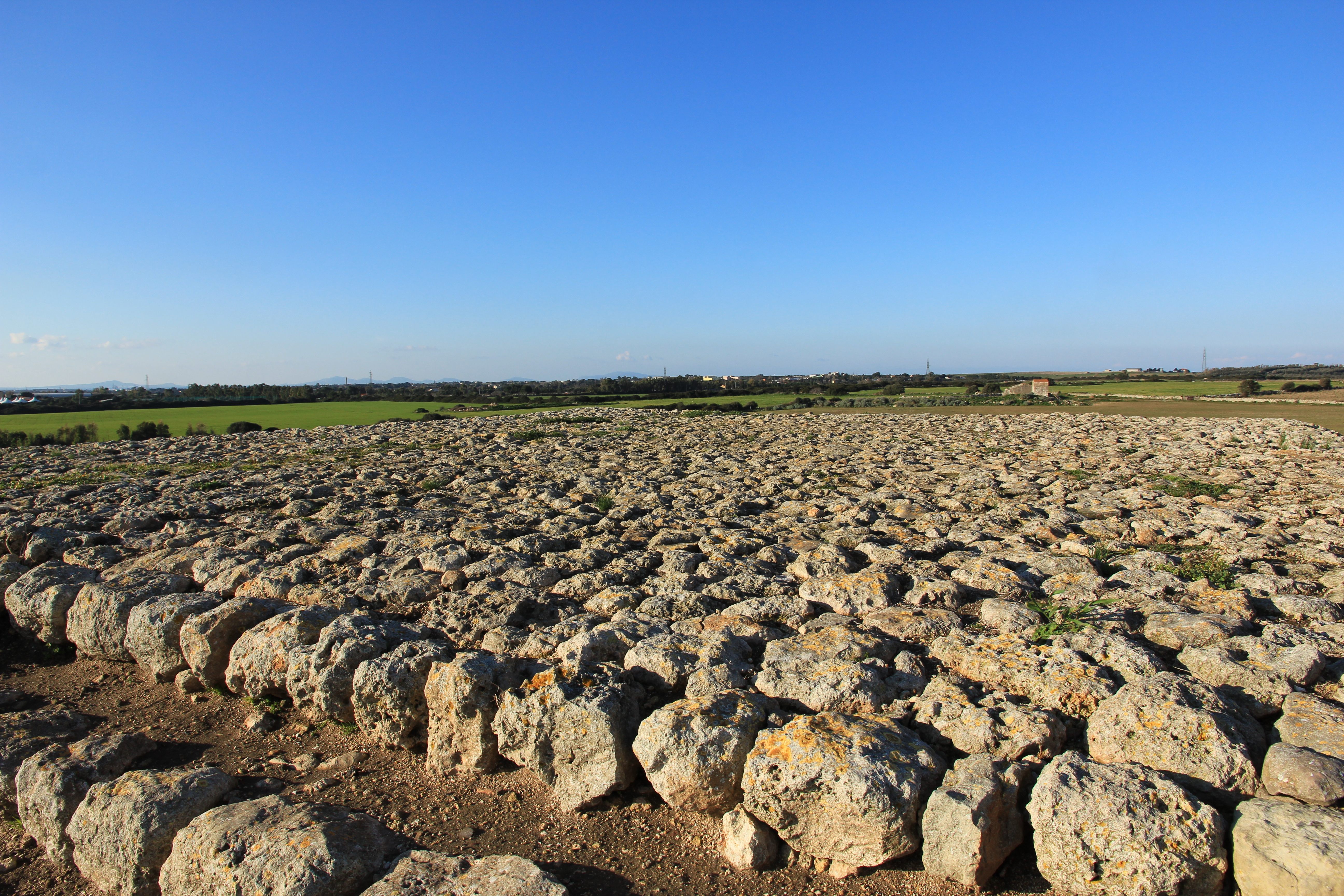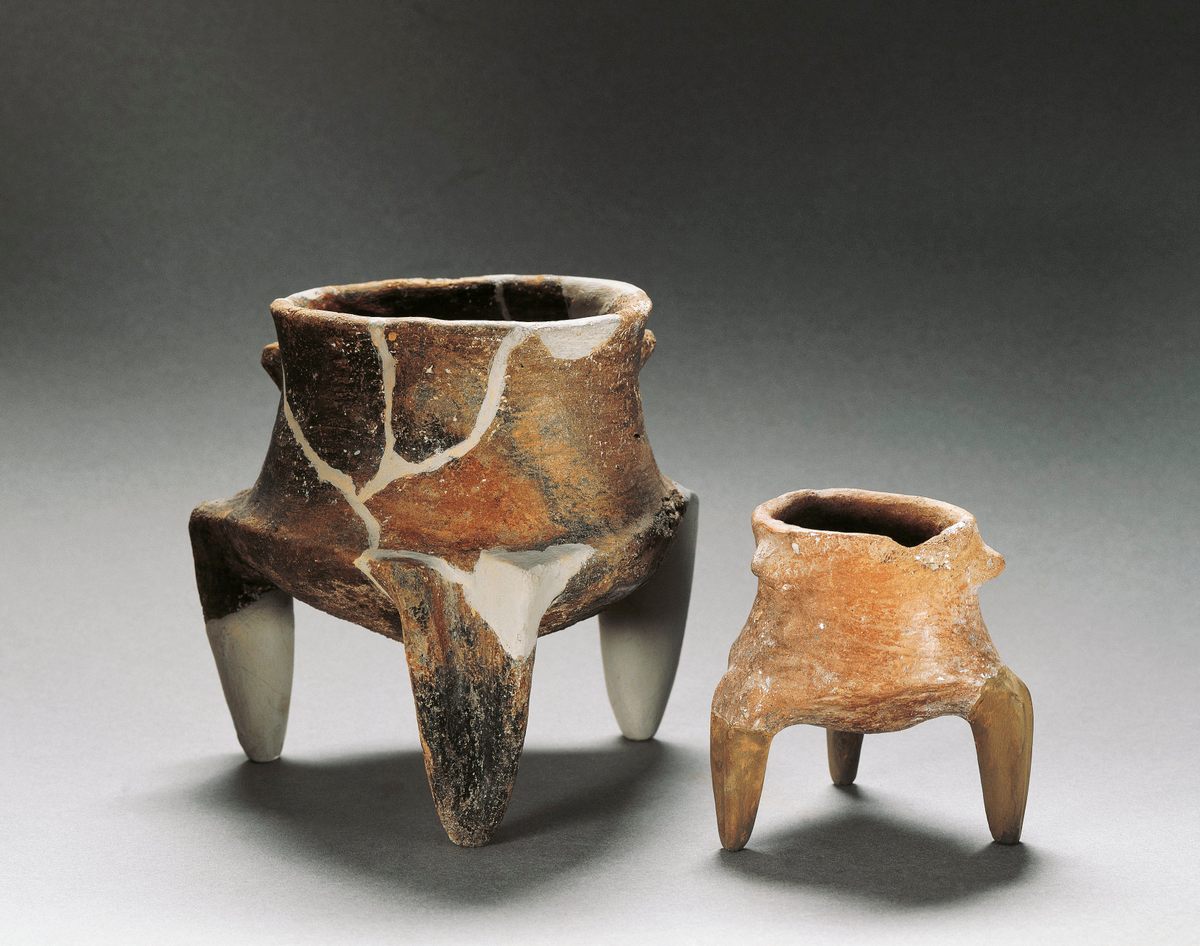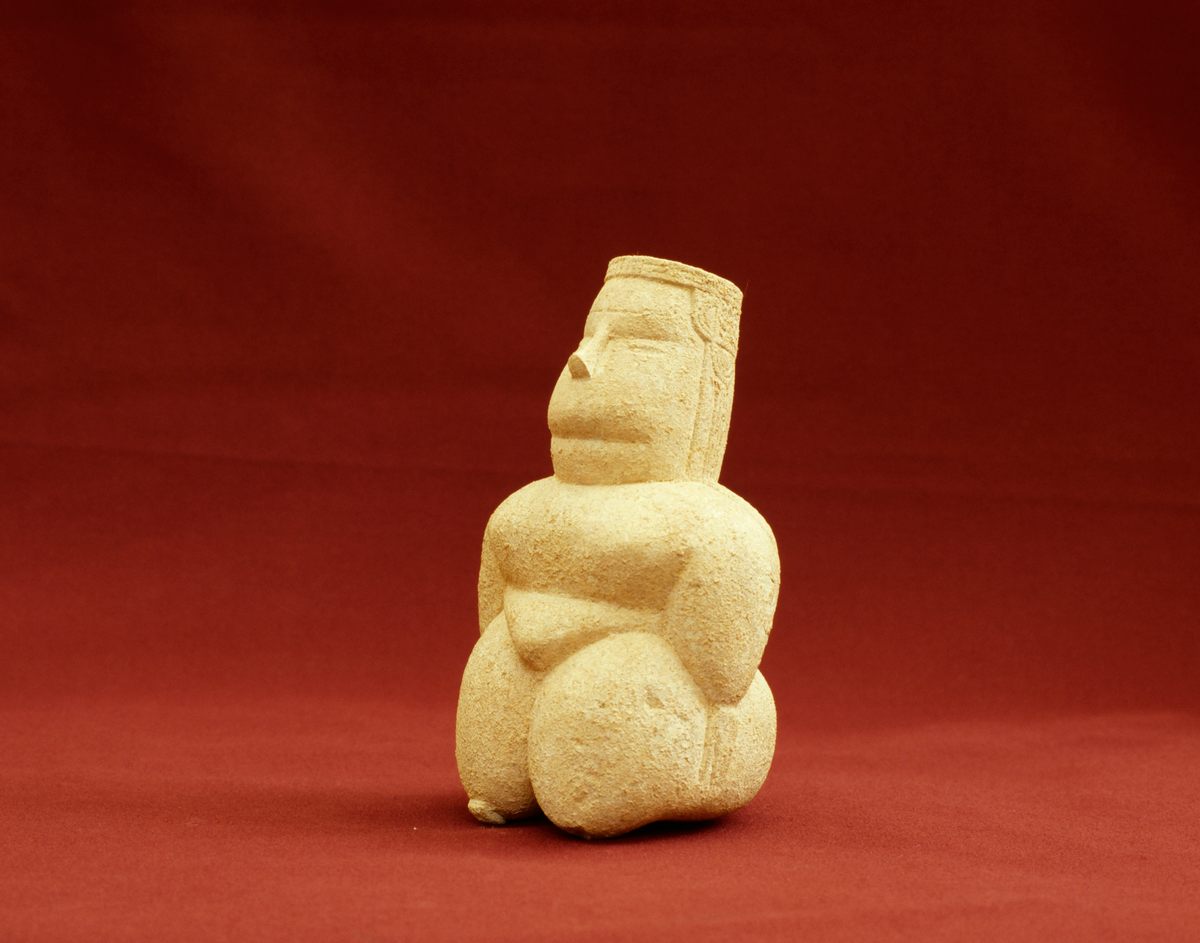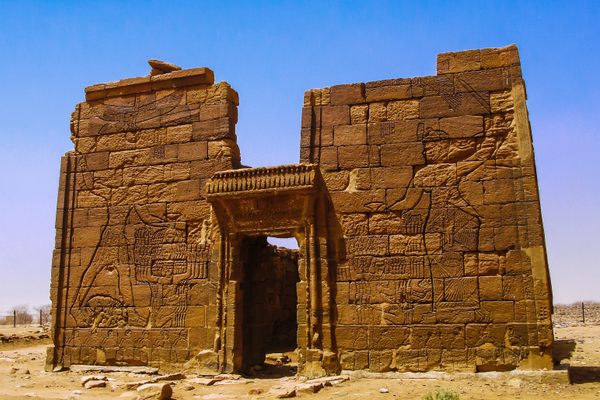This Mysterious Ziggurat Was an Ancient European Pilgrimage Site
Sardinia’s ‘mountain of stones,’ Monte d’Accoddi, is nearly 6,000 years old.
Excerpted with permission from In Sardinia: An Unexpected Journey in Italy by Jeff Biggers, published May 2023 by Melville House. All rights reserved.
The ziggurat of Monte d’Accoddi was a place of the gods, somewhere between chelu e mare, as singer Maria Carta might have sung.
That very word seemed somewhat outlandish—a ziggurat in Europe, in Sardinia of all places. Ziggurats were the ancient platform mounds and step pyramids that took shape in Mesopotamia in the fifth millennium BC like some scene out of the Tower of Babel. After driving down the back country road to reach the site, not quite seven miles from Sassari, passing farms on either side, I parked my car at a grassy clearing. At first glance, it looked like a hill; in fact, Monte d’Accoddi means a “mountain of stones.”
Stationed in the middle of the empty field like an air strip, a long ramp came into view, bordered by stones that reached a slight landing, and then it climbed a wide staircase of stone steps up to the top of a mound platform on the pyramid. Walking around to the bottom of the ramp, I stood with a mix of wonder and bewilderment.
From a distance, the pyramid had seemed eerily alone, stripped of any humanity or other signs of construction. It stretched about 120 feet by 120 feet at the base. A massive stone carved in the shape of an egg at the foot of the long ramp appeared as if someone had rolled it down the steps. The oval stone was like the omphalos at Delphi in ancient Greece, a sacred rock boulder indicating the center of the world. To one side stood a seven-foot-tall, thin menhir, like a stone totem symbol. Four other menhirs were stationed around the area. On the opposite side of the pyramid was a dolmen, a small stack of rocks similar to Stonehenge. I walked up the dirt ramp until I reached a platform, and then I began to scale the stone steps. It did not have the sharp climb of the pyramids in central Mexico; and yet, the final ascent carried the same weight of solemnity of hallowed ground. From the top of the platform, I could see the full view of the valley, the long ramp of stone steps now appearing like a sacred passage from earth to the sky. I felt the powerful role of an altar that sought to connect to the cosmos of the times.

Discovered in the 1950s, the original pyramid structure dated back to 4000-3500 BC—nearly 6,000 years ago. One thing set it apart from other ziggurats or pyramids: Monte d’Accoddi was built on a carefully arranged stone foundation, brick by brick, including the corner foundations, as well as the ramp. The ziggurats in Mesopotamia, for example, used mud bricks, not stone. According to archaeologists, the pyramid developed over two stages. The second stage around 3200 BC added an altar, where excavations have found the residue of sheep, pigs, and cattle, most likely used for sacrifices.
For all of its otherworldliness, there was something incredibly inviting about the pyramid, as if it had been built as a stepping stone to a singular moment of humanity in time. It beckoned one to scale it. I could imagine Monte d’Accoddi being a site of pilgrimage for those across the island. Standing at the top, on the platform where an altar had once been positioned to either petition the gods or defy them, I marveled at being all alone. There was no one else at the site, other than a couple of staff in a small office at the edge of the field.
While I had scaled the Tikal pyramids in Guatemala with a similar feeling of awe, this monument in Sardinia went back several more thousands of years on our timeline of existence, as a sacred landmark in Neolithic Europe. The antiquity, still preserved, signaled a hinge moment in history; it recognized an organization of civilization that literally took a step forward, and beyond what had been imagined in the past. It was truly one of the most incomparable scenes in Europe, at least in my experience.
I never would have expected such a place in Sardinia. A place where one stood on the foundations of “civilization” in Europe; a sacred space that had endured over thousands of years, I should add, drawing pilgrims from far-flung stretches of the island, and beyond.

“We are used to thinking of ‘civilization’ as something that originates in cities,” David Graeber reminded us in his book, The Dawn of Everything: A New History of Humanity, “but, armed with new knowledge, it seems more realistic to put things the other way round and to imagine the first cities as one of those great regional confederacies, compressed into a small space.”
This sentiment resonated with me often in Sardinia. The reality that architectural wonders, for example, had emerged out of the genius of small communities on a small island; and the more breathtaking reality that these massive artifacts, like the nuraghes (freestanding stone towers) and this ziggurat, still endured as a presence on the island. They were not simply legends or tales in a story, however ancient. They were not bits and pieces of stones in a museum, however enigmatic. The foundations of civilization on this island, as a nexus in the Mediterranean, and ultimately Europe, provided a glimpse into the very stepping stones of progress in an age that saw a shift from the first stone tools for organized farming to the first stone wheels that rolled into existence. In the process, these architectural marvels were assembled in Sardinia as a collective act of knowledge and ability, not as a mysterious phenomenon.
Archaeologists also found numerous tombs within the pyramid, including subterranean chambers similar to the Neolithic domus de janas burial grounds carved into rock chambers all across the island. Like many of the stone necropolis sites in Sardinia, the tombs included the carvings of bull horns as symbols of status. A whale’s tooth, among other artifacts, had been discovered, linking the inland site to the sea.
Aerial photos of the site had captured the seemingly obvious but hidden ruins in 1950. It was literally buried under mounds of dirt and overgrowth for thousands of years. Abandoned at the beginning of the Nuragic civilization, the site had been known for centuries. Most visitors, including archaeologists in the early 1900s, assumed it contained the ruins of another nuraghe. Like thousands of others, it was left to sit underground. Imagine how many other Monte d’Accoddi sites are sitting under the 7,000 nuraghes that have never been excavated in Sardinia.

It wasn’t until the 1950s, with the land owned by Antonio Segni, who would go on to become the president of Italy, that the first excavations were funded. Segni actually procured the initial funds.
A ceramic bowl with dancing figures, among other pottery pieces, was collected in the excavation. A small limestone stele with clear incisions, as if marking time or a name, appeared in one of the tombs. To be sure, it marked a lexicon on the island in ancient times. Other pieces of ceramics, as well as a male figure in red ochre, were found. In one section of the tombs, large amounts of obsidian, shells, and other materials covered the area. In fact, the limestone foundations for a village hut surrounded one side of the pyramid.
In the underworld of the tombs, archaeologists also uncovered a beautiful stone carving of a goddess. Her hands on her hips, with thin arms, and a triangular torso, the goddess had been interpreted as representing Mother Earth—la Dea Madre. The endearing figure, with her circular head and “globe” eyes, was not alone. Similar carvings of the dea madre had been found at Neolithic necropolis sites across Sardinia, from the smaller island of Sant’Antioco, to the western coasts near Cabras, to the Barbagia mountains near Orgosolo, to domus de janas sites near Alghero, Porto Torres, and Sassari. A carpenter in the 1940s near Macomer, who was digging near his orchards, found the oldest recorded female sculpture. He had reached into the ground and picked up the “Venus of Macomer,” as it is called, fractured in certain areas, but with a clear face, trunk, and thighs carved from a volcanic or basalt rock. It was recently dated to the Late Pleistocene—it’s at least 15,000 years old.
Such antiquity, mixed with art and ritual, did not feel extraneous to the island today, like some relic of another culture, but a fundamental part of the Sardinian experience.

In 2019, American archaeologist Gary Webster asked, in his own analysis: How could Monte d’Accoddi, with its singular existence, be missing from most studies on Neolithic Europe, including the most recent Oxford Handbook of Neolithic Europe, which actually featured a dea madre sculpture from Sardinia on its cover? Classical archaeology and its bevy of scholars had certainly carved out a new role for Sardinia in its once narrow corridors of western civilization. The Cambridge Prehistory of the Bronze and Iron Age Mediterranean handbook even featured a Nuragic bronze ship on its cover, as well, as if its shipment still waited to be inspected.
“The Carthaginians drown any strangers who sail past, on their voyage to Sardinia,” Strabo wrote in his Geography in Greek, sometime around the year 23, reminding us that a nation’s odyssey was not necessarily silent, but silenced. In modern times, that silencing continued in other forms.
I was also curious what was hiding in the worship of a female goddess from the Paleolithic to the Neolithic that supposedly came to an end in the Bronze Age? The emphasis on dea madre artifacts eventually shifted to Nuragic bronze and other sculptures dominated by men, including archers and warriors, boxers and wrestlers, and priests and village headsmen. The pioneering Sardinian archaeologist Giovanni Lilliu glibly remarked in 1963, perhaps as a reflection of his own times, that “in this society of men—body and soul—women bring a note of kindness and grace but also of dignity and severe composure, sometimes of a silent and solemn tragic nature: as she still is today, the Sardinian woman.”
In assessing materials found in burial tombs, as well as bronze statuettes of Nuragic priestesses, archaeologist Fulvia Lo Schiavo observed that Nuragic women actually shared an “equal treatment” in life and death rituals at a level that was “almost unique in the ancient world.” Decades after Lilliu’s pioneering Nuragic research, Lo Schiavo’s more updated analysis suggested that the “secret” of Nuragic welfare and equality for women ultimately faded into the upheaval from colonization of the Phoenicians and then the Carthaginians.

That “secret” continued to be in dispute in the 1390s, when Eleonora of Arborea became the judge or ruler of her judicadu, in defiance of the Aragon incursions onto the island. In updating and promulgating the Carta de Logu code of laws, written in Sardinian, which provided women rights for inheritance, compensation for adultery, and stricter laws for rape, Eleonora placed Sardinia ahead of most European nations in the medieval period.
“In the ‘stranger’s room’ of the Porru house a woman sat crying,” began Grazia Deledda’s novel, After the Divorce, questioning that “secret” in Sardinian life for women, 500 years after Eleonora’s reign. It was one of the first novels to deal with the theme of divorce, published in 1902.
After Deledda won the Nobel Prize for literature in 1926, an American news story noted that it was “strange” that she continued to write about Sardinia after she moved to Rome. “Sardinia holds very little interest for the world in general. It is not rich in artistic treasures as is most of Italy. Sardinia’s charm, perhaps, is its isolation; civilization has not as yet dulled it or cut it down to the standardized pattern.”
In the 1920s, Sardinian poet Marianna Bussalai, an ardent feminist voice, and an anti-fascist and independence activist from the mountain village of Orani until her death in 1947, once wrote a note to poet Antioco “Montanaru” Casula, about “the Sardinian women, quiet and ignored poetesses of the shadows.” As a performer and writer of poetry in Sardinian, Bussalai saw her Sardinian identity inseparable from her role as a woman.
Hiding Sardinian patriot Emilio Lussu from fascist forces under the trap door of her cellar, after he had fled Cagliari in 1926, she would later add: “My Sardism dates from before the Sardinian Action Party arose, that is, from when, on the benches of elementary schools, I humbled myself why in the history of Italy there was never any talk of Sardinia. I came to the point that Sardinia was not Italy and had to have a history of its own.”
Its own history, like Monte d’Accoddi, you could add, like the dea madre—and all the women in Sardinia.
























Follow us on Twitter to get the latest on the world's hidden wonders.
Like us on Facebook to get the latest on the world's hidden wonders.
Follow us on Twitter Like us on Facebook